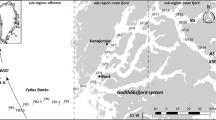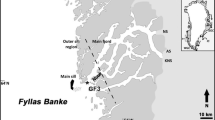Summary
Microplankton was sampled with a centrifugal suction pump in the surface layer (approx. 9 m) of the Bellingshausen Sea and the Bransfield Strait in March 1987, and concentrated with a 26μm-mesh net. Bulk microplanktonic settling volumes were assessed, silicoflagellates and large thecate dinoflagellates were counted, and tintinnids were counted and identified to species. Average (and maximum) values for the entire area surveyed were as follows, settling volume: 6.7 (43.3) ml/m3; silicoflagellates: 674 (7777) ind./l, 0.57 (6.54) mg C/m3; dinoflagellates: 109 (1321) ind./l, 1.40 (16.98) mg C/m3; tintinnids: 52 (589) ind./l, 1.15 (9.87) mg C/m3. The three geographic zones defined objectively on the basis of tintinnid specific assemblages also differed sharply in their surface salinity, overall microplanktonic abundance and bulk settling volume. The Bransfield Strait, with lowest settling volume values (2.1 ml/m3) and cell concentrations, was characterized by the dominance of Cymatocylis affinis/convallaria. In waters around the tip of the Antarctic Peninsula microplanktonic settling volumes averaged 4.6 ml/m3, cell concentrations were intermediate, and 79% of the tintinnids were represented by Codonellopsis balechi. The Bellingshausen Sea was characterized by the lowest salinities and the highest settling volumes (8.7 ml/m3) and cell counts; Laackmanniella spp. and Cymatocylis drygalskii, f. typica dominated this area. Almost all biological variables were significantly intercorrelated, and showed strong and mostly significant negative correlations with surface salinity, yet relationships between enhanced standing stock and ice meltwater were not obvious; rather, highest microplanktonic concentrations seemed to be due to ice-associated growth. Extremely high spatial correlations were found between the tintinnids and the dinoflagellates (r2: 0.941), suggesting the existence of close links between these two groups. Tintinnid species-specific assemblages show a coherent distributional pattern and well defined environment-related trends; most clearly differentiated preferences are exhibited by Laackmanniella prolongata (closely associated with ice-covered areas), Cymatocylis affinis/convallaria (oligotrophic open-ocean waters), and Codonellopsis balechi (coastal regions).
Similar content being viewed by others
References
Amos AF (1987) RACER: physical oceanography of the western Bransfield Strait. Antarct J US 22:137–140
Balech E (1958) Plancton de la campaña antártica argentina 1954–1955. Physis 21:75–108
Balech E (1971) Microplancton de la Campaña Oceanográfica Productividad III. Rev Mus Arg Cienc Nat “Bernardino Rivadavia” 3:1–202
Balech E (1973) Segunda contributión al conocimiento del plancton del Mar de Bellingshausen. Contrib Inst Antart Argentino 107:3–63
Balech E (1976) Clave ilustrada de dinoflagelados antárticos. Publ Inst Antart Argentine 11:1–99
Bersch M, Becker GA (1986) The surface expression of the Weddell-Scotia confluence. Meeresforschung 31:58–68
Boden BP (1988) Observations of the island mass effect in the Prince Edward Archipelago. Polar Biol 9:61–68
Bedungen B von (1986) Phytoplankton growth and krill grazing during spring in the Bransfield Starit, Antarctica — Implications from sediment trap collections. Polar Biol 6:153–160
Boltovskoy D, Alder VA, Spinelli F (1989) Summer Weddell Sea microplankton: assemblage structure, distribution and abundance, with special emphasis on the Tintinnina. Polar Biol 9:447–456
Boltovskoy D, Dinofrio EO, Alder VA (1990) Intraspecific variability in Antarctic tintinnids: the Cymatocylis affinis/convallaria species group. J Plankton Res 12:403–413
Boltovskoy D, Vivequin SM, Swanberg NR (submitted) Vertical distribution of tintinnids and associated microplankton in the upper layer of the Barents Sea (Arctic Ocean). Sarsia
Boltovskoy E, Boltovskoy D (1970) Foraminíferos planctónicos vivos del Mar de la Flota (Antártica). Rev Esp Micropal 2:27–44
Brandini FP, Kutner MBB (1986) Composition and distribution of summer phytoplankton in the Bransfield Strait, Antarctica. An Acad Bras Cienc [Supl] 58:3–11
Bröcket K von (1981) The importance of nanoplankton within the pelagic Antarctic ecosystem. Kiel Meeresforsch, Sonderh 5:61–67
Buck KR, Garrison DL, Hopkins TL (1987) Abundance and distribution of tintinnids in an ice edge zone: an AMERIEZ study. EOS (Trans Am Geophys Union) 68:1773
Cardin V, Zambrano E (1989) Contributión al conocimiento de la oceanografía física del Estrecho Bransfield. Acta Antart Ecuatoriana PROANTEC 1:1–17
Capriulo GM (1982) Feeding of field collected tintinnid microzooplankton on natural food. Mar Biol 71:73–86
Clowes AJ (1934) Hydrology of the Bransfield Strait. Discovery Rep 9:1–64
Dodge JD, Priddle J (1987) Species composition and ecology of dinoflagellates from the Southern Ocean near South Georgia. J Plankton Res 9:685–697
Edler L (ed) (1979) Recommendation on methods for marine biological studies in the Baltic SeaPhytoplankton and chlorophyll. Baltic mar Biol 5:1–38
El-Sayed SZ (1984) Productivity of Antarctic waters — a reapprisal. In: Holm-Hansen O, Bolis L, Gilles R (eds) Marine phytoplankton and productivity. Springer, Berlin Heidelberg, pp 19–34
El-Sayed SZ (1988) Seasonal and interannual variabilities in Antarctic phytoplankton with reference to krill distribution. In: Sahrhage D (ed) Antarctic Ocean and resources variability. Springer, Berlin Heidelberg, pp 101–119
Fogg GE (1977) Aquatic primary production in the Antarctic. Philos Trans R Soc London, Ser B 279:27–38
Fryxell GA, Kendrick GA (1988) Austral spring microalgae across the Weddell Sea ice edge: spatial relationships along a northward transect during AMERIEZ 83. Deep-Sea Res 35:1–20
Fukuda Y, Ohno M, Fukuchi M (1986) Surface chlorophyll a distribution in marginal ice zone in Antarctica, 1984/85. Mem Nat Inst Polar Res, Spec Issue 44, Proc 8th Symp Polar Biol, pp 24–33
Garrison DL, Buck KR (1987) AMERIEZ 1986: microzooplankton abundance and distribution in the ice-edge zone. Antarct J US 22:175–176
Garrison DL, Buck KR (1989) Protozooplankton in the Weddell Sea, Antarctica: abundance and distribution in the ice-edge zone. Polar Biol 9:341–351
Garrison DL, Gowing M (in press) Protozooplankton. In: Friedman EI (ed) Antarctic microbiology
Garrison DL, Ackley SF, Buck KR (1983) A physical mechanism for establishing algal populations in frazil ice. Nature 306:363–365
Hart TJ (1942) Phytoplankton periodicity in Antarctic surface waters. Discovery Rep 21:261–356
Heinbokel JF, Coats DW (1986) Patterns of tintinnine abundance and reproduction near the edge of seasonal pack-ice in the Weddell Sea, November 1983. Mar Ecol Prog Ser 33:71–80
Hewes CD, Holm-Hansen O, Sakshaug E (1983a) Nanoplankton and microplankton studies during the circumnavigation cruise. Antarct J US 18:169–171
Hewes CD, Holm-Hansen O, Sakshaug E (1983b) Alternate carbon pathways at lower trophic levels in the Antarctic food web. In: Siegfried WR, Condy PR, Laws RM (eds) Antarctic nutrient cycles and food webs. Springer, Berlin Heidelberg, pp 277–283
Holm-Hansen O, Huntley ME (1984) Feeding requirements of krill in relation to food sources. J Crust Biol 4:156–173
Holm-Hansen O, Letelier R, Mitchell BG (1987) RACER: temporal and spatial distribution of phytoplankton biomass and primary production. Antarct J US 22:142–145
Hoshiai T, Fukuchi M (1981) Sea ice colored by ice algae in a lagoon, lake Saroma, Hokkaido, Japan. Ant Rec 71:113–120
Huntley ME, Niiler P, Holm-Hansen O, Karl DM (1987) RACER: and interdisciplinary field study. Antarct J US 22:135–137
Kelly R, Blanco JL, Díaz M (1985) Hidrografía del Estrecho Bransfield durante el verano austral 1984 (Sibex-Fase I). Ser Cient Inst Antart Chileno 33:15–48
Kopczynska EE, Ligowski R (1982) Phytoplankton abundance and distribution in the southern Drake Passage and the Bransfield Strait in February–March (BIOMASS-FIBEX). Pol Polar Res 3:193–202
Kopczynska EE, Weber LH, El-Sayed SZ (1986) Phytoplankton species composition and abundance in the Indian Sector of the Antarctic Ocean. Polar Biol 6:161–169
Laackmann H (1910) Die Tintinnodeen der Deutschen Südpolar-Expedition 1901–1903. Dtsch Südpol Exped 2:341–496
Laval-Peuto M (1981) Construction of the lorica in Ciliata Tintinnina. In vivo study of Favella ehrenbergii: variability of the phenotypes during the cycle, biology, statistics, biometry. Protistologica 17:249–272
Laval-Peuto M (1983) Sexual reproduction in Favella ehrenbergii (Ciliophora, Tintinnina). Taxonomical implications. Protistologica 19:503–512
Ledenev VG (1969) Hydrological characteristics of Antarctic inshore waters. In: Atlas Antarktiki II. Gidrometeorologicheskoe Izdatelstvo, Leningrad, pp 442–448
Mamaeva NV (1986) Composition and distribution of planktonic infusorians in the Pacific sector of the Antarctic. Biol Morya 1:20–24
Morley JJ, Stepien JC (1985) Antarctic Radiolaria in late winter/early spring Weddell Sea waters. Micropaleontology 31:365–371
Nast F, Gieskes W (1986) Phytoplankton observations relative to krill abundance around Elephant Island in November 1983. Arch Fischereiwiss 37:95–106
Rojas R (1985) Descripción de la estructura térmica del Estrecho Bransfield a base de observaciones de XBT (Sibex-Fase I-Chile). Ser Cient Inst Antart Chileno 33:89–120
Sakshaug E, Holm-Hansen O (1984) Factors governing pelagic production in polar oceans. In: Holm-Hansen O, Bolis L, Gilles R (eds) Marine phytoplankton and productivity. Springer, Berlin Heidelberg, pp 1–18
Sakshaug E, Skjoldal HR (1989) Life at the ice edge. Ambio 18:60–67
Schiel SS (1989) EPOS accomplishes goals set out by international group. BIOMASS Newslett 11:1–6
Sievers HA, Nowlin WD (1988) Upper ocean characteristics in Drake Passage and adjoining areas of the Southern Ocean, 39°W295°W. In: Sahrhage D (ed) Antarctic Ocean and resources variability. Springer, Berlin Heidelberg, pp 57–80
Smith WO, Nelson DM (1986) Importance of ice-edge phytoplankton production in the Southern Ocean. Bio Sci 36:251–257
Sneath PHA, Sokal RR (1973) Numerical taxonomy. Freeman, San Francisco, pp 1–573
Spindler M, Dieckmann GS, Lange MA (1989) Seasonal and geographic variations in the sea ice community structure of the Weddell Sea, Antarctica. Submitted to 5th Symp Antarct Biol, Hobart, Tasmania, Australia
Spittler P (1973) Feeding experiments with tintinnids. Oikos [Suppl] 15:128–132
Stoecker DK, Guillard RRL, Kavee RM (1981) Selective predation by Favella ehrenbergii (Tintinnina) on and among dinoflagellates. Biol Bull 160:136–145
Stoecker DK, Davis LH, Anderson DM (1984) Fine scale spatial correlations between planktonic ciliates and dinoflagellates. J Plankton Res 6:829–842
Sushin VA, Samyshev EZ, Gaydamak AI (1986) The significance of infusoria in Antarctic plankton communities. Mar Biol [translation of Biologiya Morya] 26:740–744
Tumantseva NI (1982) Biomass and productive characteristics of protozoan plankton in Subantarctic and Antarctic waters of the southwestern Pacific. Mar Biol [translation of Biologiya Morya] 22:604–608
Verity PG (1986a) Growth rates of natural tintinnid populations in Narragansett Bay, Rhode Island. Estuar Coastal Shelf Sci 24:671–690
Verity PG (1986b) The relative food value of diatoms, dinoflagellates, flagellates, and cyanobacteria for tintinnid ciliates. Arch Protistenk 131:71–84
Verity PG, Langdon C (1984) Relationships between lorica volume, carbon, nitrogen and ATP content of tintinnids in Narragansett Bay. J Plankton Res 6:859–868
Author information
Authors and Affiliations
Rights and permissions
About this article
Cite this article
Alder, V.A., Boltovskoy, D. Microplanktonic distributional patterns west of the Antarctic Peninsula, with special emphasis on the Tintinnids. Polar Biol 11, 103–112 (1991). https://doi.org/10.1007/BF00234272
Received:
Accepted:
Issue Date:
DOI: https://doi.org/10.1007/BF00234272




